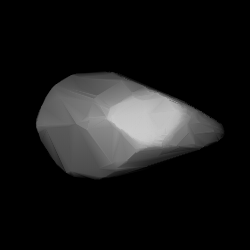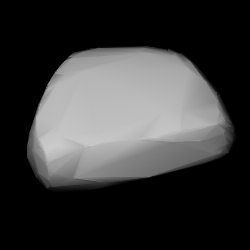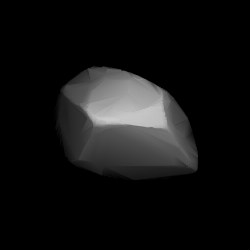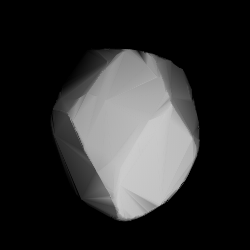Lagrangea, provisional designation 1923 OU, is a carbonaceous background asteroid from the outer region of the asteroid belt, approximately 30 kilometers in diameter. It was discovered on 12 September 1923, by Russian astronomer Sergey Belyavsky at the Simeiz Observatory on the Crimean peninsula. The asteroid was named after Italian mathematician and astronomer Joseph-Louis Lagrange.

1012 Sarema is a dark background asteroid from the inner regions of the asteroid belt, approximately 21 kilometers kilometers in diameter. It was discovered on 12 January 1924, by German astronomer Karl Reinmuth at the Heidelberg-Königstuhl State Observatory at Heidelberg, Germany. The asteroid has a rotation period of 10.3 hours and probably an elongated shape. It was named after Sarema, a character in the poem The Fountain of Bakhchisaray by Aleksandr Pushkin, and the protagonist of the opera Sarema by Alexander von Zemlinsky based upon it.

4492 Debussy is a dark and elongated background asteroid and binary system from the intermediate asteroid belt, approximately 15 kilometers in diameter. It was discovered on 17 September 1988, by Belgian astronomer Eric Elst at Haute-Provence Observatory in France. It was later named after French composer Claude Debussy.

1127 Mimi is a dark background asteroid from the central regions of the asteroid belt. It was discovered on 13 January 1929, by Belgian astronomer Sylvain Arend at the Royal Observatory of Belgium in Uccle. The carbonaceous C-type asteroids (CX) has a rotation period of 12.7 hours and measures approximately 47 kilometers in diameter. Through a glitch in the naming process, the asteroid received the name "Mimi" instead of "Robelmonte" as originally intended by the discoverer.
1151 Ithaka, provisional designation 1929 RK, is a carbonaceous asteroid from the inner regions of the asteroid belt, approximately 14 kilometers in diameter. It was discovered by Karl Reinmuth at the Heidelberg-Königstuhl State Observatory in 1929, and later named for the Greek island of Ithaca.

1652 Hergé, provisional designation 1953 PA, is a stony Florian asteroid from the inner regions of the asteroid belt, approximately 9 kilometers in diameter. It was discovered on 9 August 1953, by Belgian astronomer Sylvain Arend at the Royal Observatory of Belgium in Uccle, Belgium. It was later named after Belgian cartoonist Hergé.
1570 Brunonia, provisional designation 1948 TX, is a stony asteroid of the Koronis family from the outer regions of the asteroid belt, approximately 12 kilometers in diameter. It was discovered on 9 October 1948, by Belgian astronomer Sylvain Arend at the Royal Observatory of Belgium in Uccle. The S-type asteroid is likely elongated and has a longer-than-average rotation period of more than 48 hours. It was named for Brown University in Rhode Island, United States.
1707 Chantal, provisional designation 1932 RL, is a stony background asteroid from the Florian region in the inner asteroid belt, approximately 7.5 kilometers in diameter. It was discovered on 8 September 1932, by astronomer Eugène Delporte at the Royal Observatory of Belgium in Uccle. The S-type asteroid has a rotation period of at least 10 hours. It was named for Chantal, the niece of Belgian astronomer Georges Roland.
1232 Cortusa, provisional designation 1931 TF2, is a background asteroid from the outer regions of the asteroid belt, approximately 40 kilometers (25 miles) in diameter. It was discovered on 10 October 1931, by astronomer Karl Reinmuth at the Heidelberg Observatory in southwest Germany. The X-type asteroid has a rotation period of 25.2 hours. It was named after the plant Cortusa and indirectly honors astronomer Gustav Stracke.
3841 Dicicco, provisional designation 1983 VG7, is a stony Florian asteroid and synchronous binary system from the inner regions of the asteroid belt, approximately 5 kilometers in diameter. It was discovered on 4 November 1983, by American astronomer Brian Skiff at Lowell's Anderson Mesa Station near Flagstaff, Arizona, in the United States. It was named after American astronomer Dennis di Cicco. Its minor-planet moon, provisionally designated S/2014 (3841) 1, was discovered in 2014.
4147 Lennon, provisional designation 1983 AY, is a stony Vestian asteroid and a potentially slow rotator from the inner regions of the asteroid belt, approximately 7 kilometers in diameter. It was discovered by American astronomer Brian Skiff at Lowell's Anderson Mesa Station on 12 January 1983. It was later named after musician John Lennon.
1300 Marcelle, provisional designation 1934 CL, is a carbonaceous asteroid from the middle region of the asteroid belt, approximately 30 kilometers in diameter. It was discovered on 10 February 1934, by French astronomer Guy Reiss at the North African Algiers Observatory in Algeria.

1841 Masaryk (prov. designation: 1971 UO1) is a carbonaceous background asteroid from the outer region of the asteroid belt, approximately 46 kilometers in diameter. It was discovered on 26 October 1971, by Czech astronomer Luboš Kohoutek at Bergedorf Observatory in Hamburg, Germany. The asteroid was named after the first President of Czechoslovakia, Tomáš Garrigue Masaryk.
2043 Ortutay, provisional designation 1936 TH, is a dark asteroid from the outer regions of the asteroid belt, approximately 45 kilometers in diameter. The asteroid was discovered by Hungarian astronomer György Kulin at the Konkoly Observatory, Budapest, on 12 November 1936. It was named after Hungarian ethnographer Gyula Ortutay.

1450 Raimonda, provisional designation 1938 DP, is a background asteroid from the central regions of the asteroid belt, approximately 15 kilometers in diameter. It was discovered on 20 February 1938, by astronomer Yrjö Väisälä at the Iso-Heikkilä Observatory in Turku, Finland. The asteroid was named after Dutch astronomer Jean Jacques Raimond, Jr.
1416 Renauxa, provisional designation 1937 EC, is an Eon asteroid from the outer regions of the asteroid belt, approximately 29 kilometers in diameter. It was discovered on 4 March 1937, by French astronomer Louis Boyer at the Algiers Observatory in Algeria, North Africa. It was named after Joseph Renaux, an astronomer at the discovering observatory.
4176 Sudek, provisional designation 1987 DS, is a Themistian asteroid from the outer regions of the asteroid belt, approximately 17 kilometers in diameter. It was discovered on 24 February 1987, by Czech astronomer Antonín Mrkos at the Kleť Observatory in the Czech Republic. The presumed C-type asteroid has a rotation period of 8.16 hours. It was named in memory of Czech photographer Josef Sudek.
2391 Tomita, provisional designation 1957 AA, is a Nysian asteroid from the inner regions of the asteroid belt, approximately 15 kilometers in diameter. The asteroid was discovered on 9 January 1957, by German astronomer Karl Reinmuth at Heidelberg Observatory in southern Germany. It was named after Japanese astronomer Kōichirō Tomita.

1496 Turku, provisional designation 1938 SA1, is a Florian asteroid from the inner regions of the asteroid belt, approximately 8 kilometers in diameter. It was discovered on 22 September 1938, by astronomer Yrjö Väisälä at the Iso-Heikkilä Observatory in Turku, Finland. The asteroid was named for the Finnish city of Turku.
1803 Zwicky, prov. designation: 1967 CA, is a stony Phocaea asteroid and binary system from the inner regions of the asteroid belt, approximately 10 kilometers in diameter. It was discovered on 6 February 1967, by Swiss astronomer Paul Wild at Zimmerwald Observatory near Bern, Switzerland. It was later named after Swiss astronomer Fritz Zwicky. The discovery of a 2.5-kilometer sized companion was announced on 8 March 2021.







